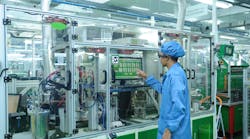After enduring months of idled factories and limited production in the wake of the global COVID-19 crisis, manufacturers are finally beginning to re-open and ramp back up toward pre-pandemic levels. However, this is no easy process.
Restarting manufacturing operations in this environment requires leaders to fundamentally reimagine their operational environment, balancing productivity needs with new processes and staffing guidelines to keep workers safe and healthy. In this environment, embracing the right blend of strategy and technology will undoubtedly determine how well manufacturers will weather the storm.
IndustryWeek recently had the opportunity to connect with Peter Herweck, executive vice president, Industry Business, Schneider Electric, to discuss the difficult decisions manufacturers face as they strategically position themselves for this "new normal."
IW: What are the next steps as manufacturers reimagine their operations to thrive under the new normal?
Herweck: The truth is no one really knows what the future will bring. That’s a big lesson from this crisis. But an interesting phenomenon has occurred: This global disruption has become a massive catalyst for innovation and collaboration. Never in my lifetime have I seen the industry come together so rapidly to find ways to navigate highly-unusual working conditions, unprecedented market dynamics, disrupted supply chains, and other interruptions. I’ll break this into three areas:
1. Workforce Empowerment
2. Operational Agility
3. Efficiency and Profitability
First, industrial enterprises are empowering their employees with the information they need to make fast, informed decisions to improve productivity and operational efficiency on the spot. Many are leveraging remote management tools so that operators can continue to adjust systems and conduct maintenance even when access to the plant is restricted.
Second, agility has taken on a new importance. As market dynamics and consumer behavior undergo drastic changes, sometimes within minutes, industrial operators must have assets available for production when needed. This is where we’ve seen asset management solutions, including analytics, improve a plant’s overall equipment effectiveness and help extend asset lifecycles.
Third, the economic impact has been profound. Most companies are using cost containment or reduction as a financial strategy to protect cash flow for business continuity and resilience. For example, energy is one of the largest non-personnel costs in many industrial operations. To offset revenue loss, manufactures are using technology to manage energy and waste costs, reduce maintenance costs, and extend asset life.IW: Are there any key concerns that should be front of mind throughout this process?
Herweck: Without doubt, the top priority continues to be securing the health and safety of employees, customers, and the community. After that, a few things remain at the top of the list for industrial enterprises:
Cybersecurity. Unfortunately, cyber-criminals ramp up activity in times of crisis. Maybe you’re receiving more phishing emails yourself. Reducing cybersecurity threats and risks to your operations is necessary for business continuity and long-term recovery. We’ve seen that companies with comprehensive cybersecurity preparation are better able to adapt to new working requirements.
When the travel ban hit, we had customers that were at critical stages of implementation. Since we could not physically access the sites, we used our secure remote access solutions to conduct and pass the factory and site acceptance tests remotely.
In many cases, companies have made cybersecurity a prerequisite for digital transformation. Which brings me to the next priority …
Digitalization. While some industrial companies have been slow to implement modern technologies, those that have moved up the digital curve are finding themselves better positioned to survive and even thrive in the new normal. The further companies are along in their digital transformation, the more agile their operations are. That means they can move quickly--and more securely—to adjust and adapt to new risks and changing market conditions; and not just global risks, but others like fluctuating feedstock and energy costs, labor costs, and government regulations.
In fact, by digitally connecting a supply chain from customers to suppliers and becoming more flexible and demand-driven, industrial enterprises are creating new business models and revenue streams. Don’t worry: the IIoT isn’t about ripping out current automation systems and replacing them with new ones. Current systems can be linked with enterprise planning, scheduling, and product lifecycle systems.
Digitalization provides the adaptability needed to thrive in whatever next normal will come our way.
IW: Understandably, the current environment has had a significant financial impact on many manufacturers. While the strategic use of technology can play a meaningful role in helping manufacturers navigate the new norm, how do businesses ensure that their investments are also preparing them to succeed long term?
Herweck: As a global manufacturing company that produces, delivers, and services a variety of products that are used around the world, Schneider Electric has learned to adapt to new business realities while also planning for the long-term. That’s why we use our EcoStruxure architecture and offerings in our own Smart Factories around the globe.
A great example is our energy efficiency program, which is built on real-time insights. It gives us full visibility and control of our energy consumption so that we can undertake continuous improvement and a strong energy savings plan. Our first implementation delivered up to 30% energy savings.
At our Lexington, Kentucky Smart Factory, operators use EcoStruxure Augmented Operator to gain visibility into operations maintenance, reducing the meantime to repair on critical equipment by 20% and eliminating paperwork by 90%.
Those are just two examples. By embracing cutting-edge technology and the benefits of the Industrial Internet of Things, we’ve been able to drive process optimization across all our Smart Factories and, in turn, reduce costs for our customers.
IW: What lessons learned should manufacturers garner considering the issues (i.e. supply chain inadequacies) that brought many firms to a painful halt? What do you see as the resulting action items?
Herweck: No doubt, this crisis has forever changed how we think about and conduct business. And it’s clear: No one company can navigate crisis alone. Persisting in this new world requires collaboration with an ecosystem of partners. Now is the time to come together and share insights and brainstorm solutions. I highly recommend we all leverage our ecosystem to connect with peers, domain experts, and partners to discover new ideas and share best practices. Collaboration is how we will find our way forward.
To learn more, join Peter and a host of industrial automation experts for Schneider Electric Innovation Talks: A Way Forward for Industry, online June 23-25, for an action plan to navigate a dynamic and disrupted world.





